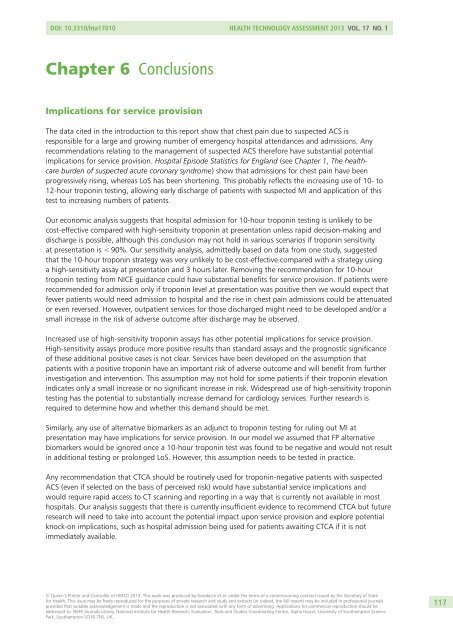Systematic review, meta-analysis and economic modelling of ...
Systematic review, meta-analysis and economic modelling of ...
Systematic review, meta-analysis and economic modelling of ...
You also want an ePaper? Increase the reach of your titles
YUMPU automatically turns print PDFs into web optimized ePapers that Google loves.
DOI: 10.3310/hta17010 Health Technology Assessment 2013 Vol. 17 No. 1Chapter 6 ConclusionsImplications for service provisionThe data cited in the introduction to this report show that chest pain due to suspected ACS isresponsible for a large <strong>and</strong> growing number <strong>of</strong> emergency hospital attendances <strong>and</strong> admissions. Anyrecommendations relating to the management <strong>of</strong> suspected ACS therefore have substantial potentialimplications for service provision. Hospital Episode Statistics for Engl<strong>and</strong> (see Chapter 1, The healthcareburden <strong>of</strong> suspected acute coronary syndrome) show that admissions for chest pain have beenprogressively rising, whereas LoS has been shortening. This probably reflects the increasing use <strong>of</strong> 10- to12-hour troponin testing, allowing early discharge <strong>of</strong> patients with suspected MI <strong>and</strong> application <strong>of</strong> thistest to increasing numbers <strong>of</strong> patients.Our <strong>economic</strong> <strong>analysis</strong> suggests that hospital admission for 10-hour troponin testing is unlikely to becost-effective compared with high-sensitivity troponin at presentation unless rapid decision-making <strong>and</strong>discharge is possible, although this conclusion may not hold in various scenarios if troponin sensitivityat presentation is < 90%. Our sensitivity <strong>analysis</strong>, admittedly based on data from one study, suggestedthat the 10-hour troponin strategy was very unlikely to be cost-effective compared with a strategy usinga high-sensitivity assay at presentation <strong>and</strong> 3 hours later. Removing the recommendation for 10-hourtroponin testing from NICE guidance could have substantial benefits for service provision. If patients wererecommended for admission only if troponin level at presentation was positive then we would expect thatfewer patients would need admission to hospital <strong>and</strong> the rise in chest pain admissions could be attenuatedor even reversed. However, outpatient services for those discharged might need to be developed <strong>and</strong>/or asmall increase in the risk <strong>of</strong> adverse outcome after discharge may be observed.Increased use <strong>of</strong> high-sensitivity troponin assays has other potential implications for service provision.High-sensitivity assays produce more positive results than st<strong>and</strong>ard assays <strong>and</strong> the prognostic significance<strong>of</strong> these additional positive cases is not clear. Services have been developed on the assumption thatpatients with a positive troponin have an important risk <strong>of</strong> adverse outcome <strong>and</strong> will benefit from furtherinvestigation <strong>and</strong> intervention. This assumption may not hold for some patients if their troponin elevationindicates only a small increase or no significant increase in risk. Widespread use <strong>of</strong> high-sensitivity troponintesting has the potential to substantially increase dem<strong>and</strong> for cardiology services. Further research isrequired to determine how <strong>and</strong> whether this dem<strong>and</strong> should be met.Similarly, any use <strong>of</strong> alternative biomarkers as an adjunct to troponin testing for ruling out MI atpresentation may have implications for service provision. In our model we assumed that FP alternativebiomarkers would be ignored once a 10-hour troponin test was found to be negative <strong>and</strong> would not resultin additional testing or prolonged LoS. However, this assumption needs to be tested in practice.Any recommendation that CTCA should be routinely used for troponin-negative patients with suspectedACS (even if selected on the basis <strong>of</strong> perceived risk) would have substantial service implications <strong>and</strong>would require rapid access to CT scanning <strong>and</strong> reporting in a way that is currently not available in mosthospitals. Our <strong>analysis</strong> suggests that there is currently insufficient evidence to recommend CTCA but futureresearch will need to take into account the potential impact upon service provision <strong>and</strong> explore potentialknock-on implications, such as hospital admission being used for patients awaiting CTCA if it is notimmediately available.© Queen’s Printer <strong>and</strong> Controller <strong>of</strong> HMSO 2013. This work was produced by Goodacre et al. under the terms <strong>of</strong> a commissioning contract issued by the Secretary <strong>of</strong> Statefor Health. This issue may be freely reproduced for the purposes <strong>of</strong> private research <strong>and</strong> study <strong>and</strong> extracts (or indeed, the full report) may be included in pr<strong>of</strong>essional journalsprovided that suitable acknowledgement is made <strong>and</strong> the reproduction is not associated with any form <strong>of</strong> advertising. Applications for commercial reproduction should beaddressed to: NIHR Journals Library, National Institute for Health Research, Evaluation, Trials <strong>and</strong> Studies Coordinating Centre, Alpha House, University <strong>of</strong> Southampton SciencePark, Southampton SO16 7NS, UK.117
















